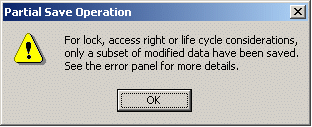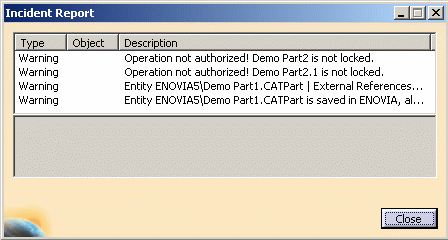If, for example, you cannot lock an object because it has already been locked by another user or if you do not want to lock it, you can still go ahead with the save operation in the knowledge that a link to any such unlocked object(s) will not prevent the locked objects you have modified from being saved. An unlocked Part may be considered as modified if you have simply consulted its properties, opened the sketch of the Part without modifying anything. Other actions (using the Show / No Show function, editing in context) can also lead to a unlocked Part being considered unsavable but all other Parts linked to it cannot be saved either unless you use the partial save.
A typical example is where:
- A Product points to a Part.
- This Product is locked by user A.
- The Part is either not locked or is locked by user B.
- The Part is considered as modified by a non-modifying action such as property consultation or sketch opening without edition.
- Result: User A cannot store the modified Product using the normal save procedure. To do so, he/she does a partial save.
Following the save, you will be notified that a partial save has been performed and you will receive a report telling you exactly what has and what has not been saved.
-
linked to a document or Publication
-
a prerequisite of a linked object, or
-
a contextual link.
If you prefer to adopt a "maximum save" approach, be sure to activate the Partial Save functionality as follows:
Open the Options dialog box using the Tools > Options... command, select the General > Compatibility category then, in the ENOVIA V5 tab, check the Partial Save authorized box:
-
Let us suppose you have opened the following assembly:

As you can see, there are two Part instances:
- Demo Part1.1
with its CATPart Demo Part1 --- attached. You have already locked this data. - Demo Part2.1
with its CATPart Demo Part2 --- attached. This data is unlocked.
There is a contextual link between the two CATPart documents.
-
Modify both CATPart documents.
-
Select the Save in ENOVIA... command in the ENOVIA V5 menu or select the
 icon in the ENOVIA V5 menu.
icon in the ENOVIA V5 menu. -
Click OK. The following message is displayed:

-
Click OK. The following incident report is displayed:

-
The first two warnings clearly mention the fact that Demo Part2.1 and the CATPart Demo Part2 have not been locked and cannot therefore be saved.
-
Click on the third and fourth warnings in the list to see them in their entirety:
Entity ENOVIA5\Demo Part1.CATPart | External References is saved in ENOVIA, although in relationship with the modified and non-savable entity ENOVIA5\Demo Part2.CATPart
Entity ENOVIA5\Demo Part1.CATPart is saved in ENOVIA, although in relationship with the modified and non-savable entity ENOVIA5\Demo Part2.CATPart
These two messages tell you that in spite of the contextual link between the two CATPart documents, both the link and the CATPart Demo Part1 itself have been saved.
-
Click Close.
![]()